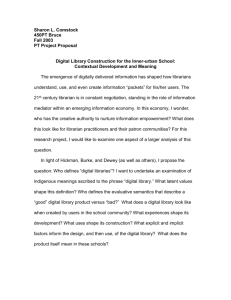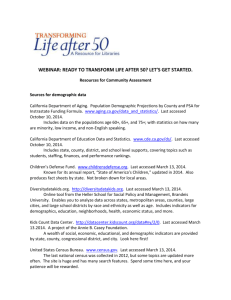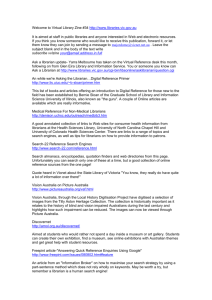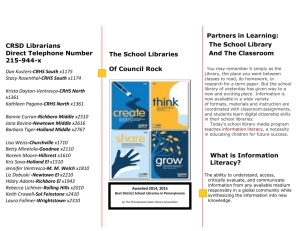Microsoft Word
advertisement
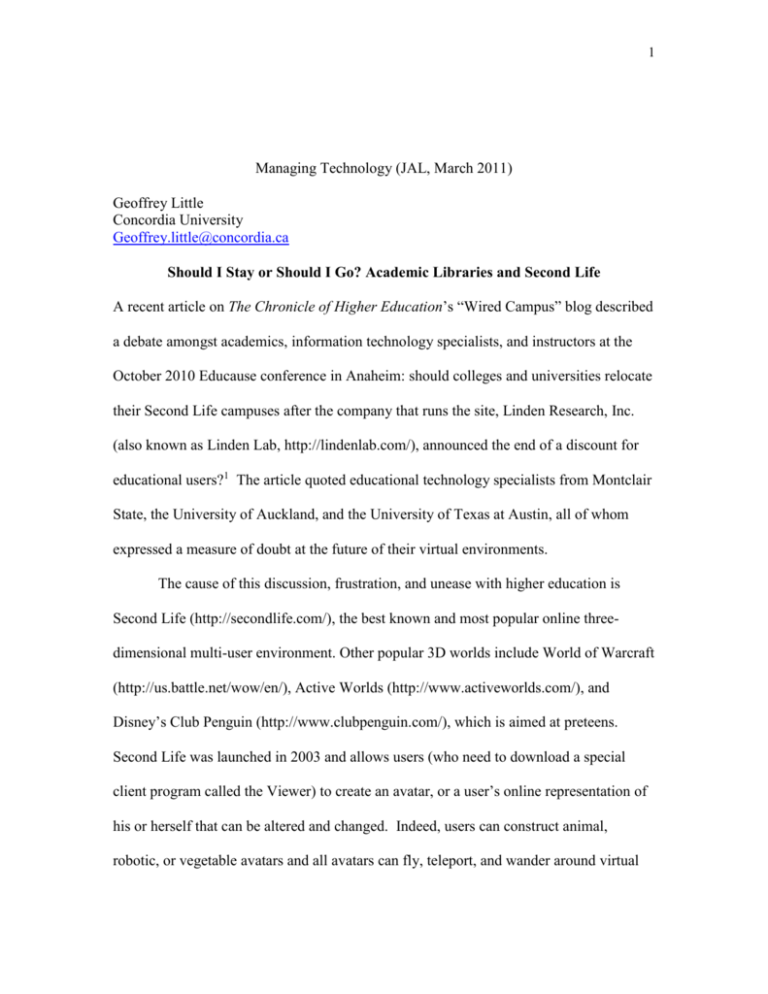
1 Managing Technology (JAL, March 2011) Geoffrey Little Concordia University Geoffrey.little@concordia.ca Should I Stay or Should I Go? Academic Libraries and Second Life A recent article on The Chronicle of Higher Education’s “Wired Campus” blog described a debate amongst academics, information technology specialists, and instructors at the October 2010 Educause conference in Anaheim: should colleges and universities relocate their Second Life campuses after the company that runs the site, Linden Research, Inc. (also known as Linden Lab, http://lindenlab.com/), announced the end of a discount for educational users?1 The article quoted educational technology specialists from Montclair State, the University of Auckland, and the University of Texas at Austin, all of whom expressed a measure of doubt at the future of their virtual environments. The cause of this discussion, frustration, and unease with higher education is Second Life (http://secondlife.com/), the best known and most popular online threedimensional multi-user environment. Other popular 3D worlds include World of Warcraft (http://us.battle.net/wow/en/), Active Worlds (http://www.activeworlds.com/), and Disney’s Club Penguin (http://www.clubpenguin.com/), which is aimed at preteens. Second Life was launched in 2003 and allows users (who need to download a special client program called the Viewer) to create an avatar, or a user’s online representation of his or herself that can be altered and changed. Indeed, users can construct animal, robotic, or vegetable avatars and all avatars can fly, teleport, and wander around virtual 2 “islands” or spaces created by other users (called residents), and they can also interact with other avatars. Second Life advertises itself as a place to live, shop, do business, learn, and find love, and the site even uses its own currency, the Linden dollar. As interest began to build around Second Life earlier this century, colleges and universities set up virtual campuses or buildings and some also utilized it for teaching and learning. Ball State, NYU, Pepperdine, and the Harvard Extension School began offering part or entire classes in Second Life2,3 and Yale started to use it in 2007 for space planning in the Seeley G. Mudd Library, originally built as an on-campus high-density shelving facility and government documents library.4 The goal of the Mudd Library simulation was to plan a possible renovation, although the university has subsequently revealed that the building is to be demolished.5 Vassar created a virtual Sistine Chapel in 2007,6 Case Western began to offer virtual campus tours,7 and MIT, Princeton, and Cornell all erected virtual 3D campuses.8 Librarians rarely lag behind their teaching colleagues in embracing new kinds of instructional technology and public and academic libraries around the world began to experiment with virtual libraries and services in Second Life. Many may have been motivated by a 2007 Gartner Report that claimed that “80 percent of active Internet users (and Fortune 500 enterprises) will have a ‘second life’” by the end of 2011.9 The Alliance Library System established a series of library spaces within Second Life in 2006 (now called the Community Virtual Library, http://infoisland.org/), which are staffed by librarian volunteers from around the world, and ALA even offered an Second Life component to its 2009 Midwinter meeting.10 A variety of articles on academic libraries and Second Life also began to appear in the professional and scholarly literature from 3 2006 onwards, with the vast majority published between 2007 and 2008. A search of Wilson’s Library Literature & Information Science Full Text database, for example, returns 73 articles on Second Life published in LIS journals and periodicals between 2008 and 2006, 23 of them in peer-reviewed publications. What were the predications about Second Life and its potential for academic libraries then and where are we now? Rhonda B. Trueman, a librarian at Johnson & Wales University, wrote in a 2006 article in Reference Services Review that “Second Life is more than just a game. It is an active, growing, learning environment...there is a depth to education through Second Life that may exceed traditional learning.”11 Her co-author, Esther Grassian from UCLA’s College Library, also postulated that Second Life could be used to reach students and researchers who don’t know what they don’t know: “We can extend our reach by going to our potential users, including those who may not know they have an information need.”12 A year later, information consultant Jill Hurst-Wahl described what she saw as the ways in which librarians could get involved in Second Life including: providing library services to residents; networking with other librarians; collaborating with new and existing partners like museums, schools, educators, and vendors; space planning; supporting other Second Life projects; supporting virtual communities generally; and the promotion of virtual spaces for education.13 Promoting Second Life as a way to reach users of science and technology libraries, Kari Swanson, a Yale science librarian, wrote in 2008 that “in Second Life we can much more easily give every user the environment that will best suit their information seeking style and needs,”14 while that same year Cybèle Elaine Werts told readers of Education Libraries that “there remains a mandate for all of us to hop on the Information Highway, or rather 4 teleport out to Second Life.”15 Also in 2008, Lynn Parker, a librarian at the University of Sheffield, posited that Second Life may become “the seventh face” of the library in concert with the library’s historic and emerging roles as a collector of books and journals, a social place for interaction, and as a presence on the Internet and on social media sites like Facebook and Twitter.16 At the other end of the spectrum, Mark Herring, dean of library services at Winthrop University in South Carolina, described his disillusionment with Second Life in a 2007 article in Library Journal. After he and a “tech guru” colleague spent some time on the site, he noted that “A handful of academic libraries are…present on Second Life, busily working away, reaching out to would-be gnomes and out-of-the-closet sprites. But here's a novel idea. Wouldn't all this human—let me phrase it euphemistically—ingenuity be better served if applied to real libraries?”17 In looking at academic librarian and staff training in 2009, Kristine S. Condic contended that Second Life had value and some potential in facilitating professional development, but concluded that “the steep learning curve, lack of privacy, and hardware requirements mean that only those dedicated employees with enough free time in their first life will be able to venture successfully into a Second Life.”18 At the same time, there are only a few examples of academic libraries that have described the planning, implementation, and assessment of projects within Second Life. The libraries at McMaster and McGill Universities in Canada, both members of ARL, established Second Life chat reference pilots in 2006 and 2007, respectively, and the two librarians who managed the initiatives published their findings in a recent issue of The Reference Librarian. In the case of McMaster, 121 questions were received in Second 5 Life during a first pilot period (of which 23 were considered “real” reference questions) compared to 97 in a second. For its part, McGill received fewer questions, most of which had to do with the university or with Montreal. In evaluating her institution’s participation, McMaster’s Krista Godfrey posited that instead of continuing to use Second Life for virtual or chat reference, the library will instead make an effort “to forge faculty partnerships and target individual classes that will excel in the virtual environment.”19 A few years later, both McMaster and McGill have discontinued their experiments in Second Life. According to Godfrey, the users “just aren’t there yet” and the time required to train librarians and to staff the service ultimately proved difficult in the face of other demands.20 Despite all of this, both Godfrey and her co-author, McGill librarian Amy Buckland, believe that there is still an interest in and future for immersive online 3D environments. Godfrey notes that Second Life may disappear, but it is only a matter of time before virtual 3D technology catches up with users’ expectations. Buckland also contends that online immersive environments will become more important in the delivery of distance and continuing education and could also become places for libraries to host virtual exhibits and digital surrogates of items from their special collections.21 If all this is true, how should academic libraries begin to plan for future close encounters of the third (dimensional) kind? Godfrey and Buckland may have proposed the “middle way” for academic libraries within Second Life or future 3D environments—supporting faculty projects or class activities or partnering in larger institutional activities rather than trying to establish, staff, promote, and maintain an active, dedicated Second Life presence for library reference, instruction, and outreach. 6 Meanwhile in Real Life circa 2011, Second Life use seems to have reached a plateau according to a number of sources, including Linden Lab itself. Data published by the company reveals that average monthly logins in Second Life in the third quarter of 2010 were 789, compared to 749 logins during the third quarter of 2009, and user hours also fell from 118 to 105 in within the same period of time.22 Joe Sanchez, who edited a special issue of Library Technology Reports on Second Life in 2009, notes that 90% of new users don’t visit Second Life after their initial first visit and, moreover, the Pew Internet and American Life Project has reported that just 4% of adults under 30 who use the Internet visit 3D worlds like Second Life compared to 7% of teens age 14-17.23,24 Other authors and practitioners have also pointed out that there are a number of significant usage barriers to Second Life including difficulty learning how to move, fly, and teleport, the need for a powerful computer with a robust Internet connection, and issues with navigating the Second Life interface.25 This combined with uncertainty at Linden Lab’s future has dulled some of the earlier excitement over Second Life. Commenting on the news of yet another departure from the Linden Lab executive team on his Computerworld blog in June 2010, Mitch Wagner wrote, “I’m afraid I don’t see much of a future for Second Life.”26 While Linden Lab appears to be looking into ways to make Second Life accessible on mobile devices like iPads and cell phones, institutions like Duke and Boston College are exploring open source/open community alternatives to the site. The interest in alternative online communities is such that the Mellon and National Science Foundations have both given grants to Duke’s Open Cobalt Project (www.opencobalt.org).27 7 From this perspective, it seems like the promised benefits of academic libraries’ participation in Second Life have not materialized, but who knows what the future will bring. In his Library Journal article, Mark Herring lamented that “Librarians can be an indiscriminate sort when it comes to technology. We are, or rather have become, something of a gadget-possessed profession.”28 This statement paints with a pretty broad brush and reinforces the image of librarianship as an overly cautious and rigid profession. We do not often encourage or support taking risks or piloting new projects using new and untried technologies or resources, but Herring would likely admit that some gadgets have proven their relative worth in libraries over the past several decades (i.e., photocopy machines, magnetic tape, punch cards). It is worthwhile exploring and evaluating a new technology and online resource like Second Life, adopting it where it proves useful and moving on when it is not. Experimentation and failure should not be mutually exclusive but, in the case of Second Life, is it time for academic librarians to get off the island or at least scan the horizon for brighter shores? Notes and References Jeffrey R. Young, “Academics Discuss Mass Migration from Second Life,” Chronicle of Higher Education, October 14, 2010, accessed November 29, 2010, http://chronicle.com/blogs/wiredcampus/academics-discuss-mass-migration-from-second-life/27672. 2 Christine Lagorio, “The Ultimate Distance Learning,” New York Times, January 7, 2007, accessed December 10, 2010, http://www.nytimes.com/2007/01/07/education/edlife/07innovation.html. 3 “Berkman Center and Harvard Extension School to Offer First University Course through Second Life, a 3-D Virtual Environment,” Berkman Center for Internet & Society, accessed December 2, 2010, http://cyber.law.harvard.edu/newsroom/cyberone 4 Grace Patuwo, “Virtual World, Read Money in ‘Second Life,’ Yale Daily News, February 11, 2010, accessed December 11, 2010, http://www.yaledailynews.com/news/2010/feb/11/virtual-world-real-moneyin-second-life/. 5 Paul Needham, “Drawings Give First Look at New Colleges,” Yale Daily News, May 12, 2009, accessed December 11, 2010, http://www.yaledailynews.com/news/2009/may/12/drawings-give-first-look-at-newcolleges/. 6 “More Than Three Thousand Flock to Vassar’s Sistine Chapel,” Vassar College, accessed December 14, 2010, http://www.vassar.edu/headlines/2007/sistine-chapel.html. 1 8 “High School Students Experience Case through the Virtual World of Second Life,” Case Western Reserve University, accessed December 9, 2010, http://blog.case.edu/case-news/2007/04/20/secondlife. 8 Andrea Foster, “MIT and Princeton Face Off in Second Life,” Chronicle of Higher Education, October 2, 2007, accessed December 2, 2010, http://chronicle.com/blogs/wiredcampus/mitprinceton-face-off-insecond-life/3374. 9 “Gartner Says 80 Percent of Active Internet Users Will Have A "Second Life" in the Virtual World by the End of 2011,” Gartner, accessed November 29, 2010, http://www.gartner.com/it/page.jsp?id=503861. 10 “ALA to promote Midwinter Meeting programming in Second Life,” American Library Association, accessed December 4, 2010, http://www.ala.org/ala/newspresscenter/news/pressreleases2009/january2009/alasecondlifemw.cfm. 11 Esther Grassian and Rhonda B. Trueman, “Stumbling, Bumbling, Teleporting and Flying…Librarian Avatars in Second Life,” Reference Services Review 35 (2006): 86. 12 Grassian and Trueman, 87. 13 Jill Hurst-Wahl, “Librarians and Second Life,” Information Outlook, June 1, 2007, accessed December 14, 2010, http://elibrary.bigchalk.com. 14 Kari Swanson, “Second Life: A Science Library Presence in Virtual Reality,” Science and Technology Libraries, 27 (2007): 85. 15 Cybèle Elaine Werts, "Information Literacy in Second Life and in Real Life," Education Libraries 31 (Winter 2007): 10. 16 Lyn Parker, “Second Life: The Seventh Face of the Library?” (2008): 3, accessed December 10, 2010, http://eprints.whiterose.ac.uk/4745/. 17 Mark Y. Herring, “Get a (Real) Life,” Library Journal, May 15, 2007, accessed December 1, 2010, http://www.libraryjournal.com/lj/ljinprintcurrentissue/883561-403/backtalk_get_a_real_life.html.csp. 18 Kristine S. Condic, “Using Second Life as a Training Tool in an Academic Library,” The Reference Librarian 50 (2009): 344. 19 Amy Buckland and Krista Godfrey, “Save the Time of the Avatar: Canadian Academic Libraries Using Chat Reference in Multi-User Environments,” The Reference Librarian 51 (2010): 23. 20 Krista Godfrey, telephone conversation with the author, December 6, 2010. 21 Amy Buckland, telephone conversation with the author, December 9, 2010. 22 “The Second Life Economy in Q3 2010,” Second Life/Linden Research, Inc., accessed December 10, 2010, http://blogs.secondlife.com/community/features/blog/2010/10/28/the-second-life-economy-in-q32010. 23 Joe Sanchez, “Barriers to Student Learning in Second Life,” Library Technology Reports 45 (February/March 2009): 29. 24 “Adults, Teens and Virtual Worlds,” Pew Internet & American Life Project, accessed December 2, 2010, http://www.pewinternet.org/Reports/2010/Social-Media-and-Young-Adults/Part-3/5-Adults-teens-andvirtual-worlds.aspx. 25 Sanchez, 29-30; Parker, 4; Condic, 343. 26 Mitch Wagner, “Second Life CEO Looks to the Future, After Massive Layoffs,” June 10, 2010, accessed November 20, 2010, http://blogs.computerworld.com/16303/second_life_layoffs. 27 Jeffrey R. Young, “After Frustrations in Second Life, Colleges Look to New Virtual Worlds,” Chronicle of Higher Education, February 14, 2010, accessed November 27, 2010, http://chronicle.com/article/AfterFrustrations-in-Second/64137/. 28 Herring. 7
